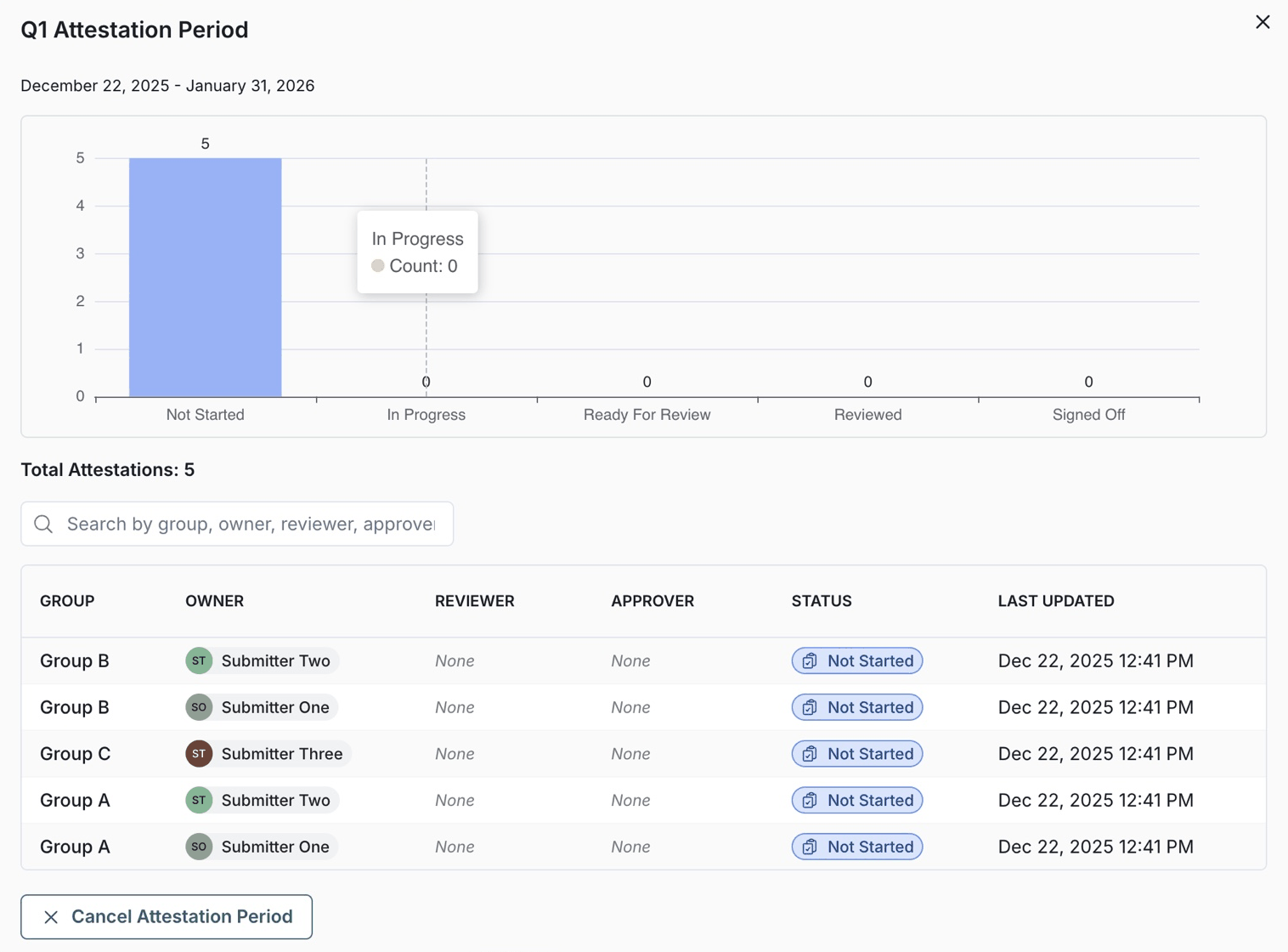graph TD
subgraph Submitter
A["**Not Started**"] --> B["**In Progress**"]
B --> C["**Ready for Review**"]
end
subgraph Reviewer
C --> D["**Reviewed**"]
D -.-> B
end
subgraph Approver
D --> E["**Signed Off**"]
end
Working with attestations
Attestation enables submitters, reviewers, and approvers to formally certify, review, and sign off on model attributes at specific points in time, supporting compliance and governance processes.
Prerequisites
-
- Customer Admin — Sets up attestations
- Submitter — Stakeholder who submits attestation questionnaires
- Reviewer — Organizational role that reviews attestation questionnaires
- Approver — Organizational role that approves attestation questionnaires
Key concepts
- attestation
- A formal process where attestation participants certify key model information at a specific time. Attestation is part of your audit trail and confirms that governance, documentation, and control requirements are met.
- attestation instance
- The invocation of the attestation process on the ValidMind Platform. Created when the attestation is triggered by the schedule you set up, it includes a snapshot with model activity and artifacts, questionnaire responses and review status, forming a full record of the review and approval process.
- attestation participant
- A user assigned to one of three roles in the attestation workflow — submitter, reviewer, or approver. Submitters must be model stakeholders; reviewers and approvers can be assigned by stakeholder or role.
- attestation period
- The time window during which attestation is active, with fixed start and end dates. Each period creates an unchanging model snapshot. Periods are usually scheduled quarterly or annually and can align with regulatory or internal cycles.
- attestation questionnaire
- A structured form that submitters use to confirm model status, documentation and compliance. It supports formatted inputs like checkboxes and text fields, serving as both a compliance check and formal review record.
- execution schedule
- The mechanism, manual or automated, that starts the attestation process based on set periods. It creates attestation instances, triggers snapshots and begins the workflow for attestation participants.
- group
- An organizational unit that associates models with specific teams or functions. When reviewers or approvers are assigned by role, they can only act on models within groups they belong to — resulting in one attestation submission per model owner per group.
- inventory scope
- The filter conditions that define which models are included in an attestation. Scope can be set using rules based on model fields, stages, or custom attributes.
- snapshot
- A fixed capture of model data at a specific time. It includes optional custom fields and related artifacts and stays unchanged throughout the attestation, ensuring historical accuracy.
How does the attestation process work?
Attestation on the ValidMind Platform begins at the start of the attestation period after the process has been set up initially. The platform captures a snapshot of each model and its artifacts, preserving the state at that point in time. Changes made after the process starts do not affect the historical record.
Responsibilities for the attestation process are shared:
The attestation process — Submitter, reviewer, and approver responsibilities
Attestation participants access their tasks via My Inbox in the left sidebar. Tasks appear under the Tasks tab with the current attestation status, also known as attestation instances.
The submitter is responsible for completing the questionnaire and addressing change requests. The reviewer is responsible for reviewing the questionnaire and requesting any necessary changes. The approver is responsible for signing off on the questionnaire.
Plan your attestation periods ahead of time to ensure they can be completed on time. The start date must be today or a future date, and you cannot set a date in the past to trigger attestation retroactively.
How are attestation submissions organized?
Attestation submissions are organized by owner AND group. This structure supports organizations where:
- Model owners may own models across multiple groups, such as Fraud and Know-Your-Customer (KYC).
- Each group has its own validation and governance team
- Reviewers and approvers are roles scoped to specific groups
How do I create meaningful attestation questionnaires?
Attestation questionnaires are typically used in model risk management to confirm that key controls, governance processes and documentation requirements have been followed throughout a model’s lifecycle. These questionnaires are part of a broader effort to ensure accountability and regulatory compliance.
Areas typically covered in the questionnaire:
Verification of responsibilities — Attests that model owners, developers and validators have performed their roles in accordance with internal policies and procedures.
Documentation of compliance — Confirms that required documentation — such as model documentation, validation reports and change logs — has been completed and properly archived.
Evidence of control operation — Serves as formal evidence that key controls (for example: backtesting, performance monitoring, version control) are in place and functioning as intended.
Governance checkpoints — Used as checkpoints at critical stages, such as model approval, annual reviews or retirement, to ensure all required steps have been completed before proceeding.
Regulatory reporting — In regulated environments, provides a documented trail that can be reviewed during internal audits or by external regulators.
Risk ownership and accountability — By signing off on questionnaires, individuals acknowledge their responsibilities and support a strong control culture.
Work with your model risk management team to create a template that accurately reflects your organization’s attestation requirements.
